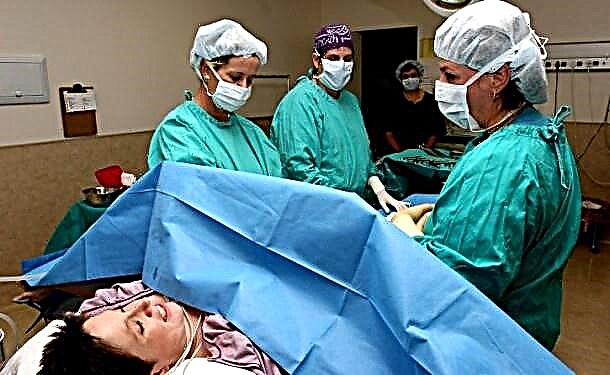
The skin of a newly born baby quite often acquires a yellow color in the first days of life - in more than 50% of full-term babies and in 70-80% of premature babies. For every mother, such changes will cause anxiety, but yellowness of the skin is not always a sign of a disease. Why can a newborn's skin turn yellow and how to determine if this is a normal stage of development or a disease?

What is it?
The acquisition of a yellow tint by the skin is called jaundice. This is not a disease, but only a symptom that can occur in a newborn, both for physiological reasons, and for various diseases.
A yellow skin tone is associated with an excess of bilirubin, a pigment formed when hemoglobin breaks down. In its free form, it is toxic to the body and is able to penetrate into the brain cells; therefore, in healthy people in the liver, this pigment is converted into a bound form (soluble in water), which safely leaves the body with feces and urine.
In the next video, Dr. Komarovsky will explain in more detail why baby jaundice occurs.
Types of jaundice
Jaundice in infants of the first month of life is divided into physiological and caused by various pathologies (pathological). Given the cause, pathological jaundice is:
- Hemolytic. It is caused by the breakdown of a large number of red blood cells.
- Parenchymal. It is caused by liver disease that affects hepatocytes.
- Conjugation. It is caused by problems with the binding of bilirubin.
- Obturation. It is caused by obstructions in the biliary tract.
Separately, jaundice caused by estrogens and special fatty acids in breast milk is distinguished - it is called breastfeeding jaundice. It is not dangerous, appears in the second week of life and can last up to 2-3 months of age, showing only a yellow skin tone. A toddler with such jaundice gains weight well, suckles with appetite and sleeps normally.

Causes
The appearance in infants of the second or third day of life of the physiological form of jaundice is associated with:
- The breakdown of a large amount of hemoglobin. We are talking about fetal hemoglobin, which was needed during intrauterine development, and after birth is replaced by normal (adult) hemoglobin.
- Immaturity of the enzymatic system of the liver, as a result of which it is impossible to bind all the pigment formed during the breakdown of hemoglobin.
- Prolonged passage of feces through the intestines and unformed microflora, due to which part of the bilirubin enters the bloodstream back.
Hemolytic jaundice in infants in the first days of life is most often caused by the incompatibility of the baby's blood with the mother's blood by the Rh factor or by group.
The causes of parenchymal jaundice in a newborn are:
- A viral disease that affects the liver.
- Hereditary liver disease.
The causes of conjugational jaundice can be a hereditary disease, hormonal disorder, or treatment of the baby with certain medications.
Obstructive jaundice can be caused by mechanical damage to the biliary tract and diseases of the gallbladder, for example, genetic.
Factors that increase the risk of jaundice in newborns include:
- Prematurity.
- Delayed fetal development.
- The expectant mother is taking many medications.
- Significant weight loss after birth.
- Hemorrhages during childbirth.
- Asphyxia in childbirth.
- Intrauterine infection.
- Diabetes mellitus in the expectant mother.
- Refusal to breastfeed.

Symptoms
The main symptom of jaundice in a newborn baby is yellowing of the skin. If the jaundice is physiological, it appears on the second or third day of life and in most children it does not fall below the navel (the head and upper part of the body turn yellow). At the same time, the skin tone is bright, most pronounced for 3-5 days of life, and then begins to fade.
With pathological jaundice, the skin may change its color earlier (sometimes the baby is already born yellow), and later, while the symptom may last longer and appear in periods (wavy). A possible obstructive jaundice may be indicated by a greenish skin tone.

Other manifestations of jaundice in a newborn are presented in the table:
Treatment
In each specific case of jaundice in a newborn, the doctor should decide on the appropriateness and tactics of treatment. Physiological jaundice in most babies is not treated at all, as it goes away on its own.
If the bilirubin level is alarmingly high, the baby is given phototherapy. This is the most common, simple and safe way to get rid of free bilirubin in your baby's blood. It involves staying under special lamps, the light of which converts toxic bilirubin into a harmless form.
Other treatments that can be given to an infant with jaundice include:
- Infusion therapy. It is often prescribed in cases where the baby is unable to breastfeed. The baby is injected intravenously with glucose, saline solutions, proteins and vitamins.
- Blood transfusion. This method of treatment is resorted to when the baby is in serious condition, for example, if the baby has a Rh-conflict.
- Medicines with a choleretic effect. Usually prescribed for cholestasis and conjugative jaundice, when the liver does not cope well with its function of binding bilirubin.
- Sorbents to prevent the reabsorption of pigment from feces.
- Surgical intervention for obstructive jaundice.

Possible consequences
One of the most dangerous complications of jaundice caused by an excessively high level of bilirubin is damage to the subcortical nuclei of the brain. This complication is called kernicterus. At the first stage of its development, the baby becomes lethargic, sleeps a lot, refuses to suckle, bends over, throws its head back.
If you do not take measures to reduce the level of bilirubin, the child's liver enlarges, the body temperature rises, convulsions, a loud cry, and tension of the muscles of the neck appear. In severe cases, the baby may die from apnea or coma. Children who have suffered from nuclear jaundice may subsequently experience problems such as paralysis, deafness, and mental retardation.
How many days does jaundice most often pass?
If the appearance of a symptom is caused by physiological reasons, as a rule, the yellowness of the skin subsides by 10-14 days of a full-term baby's life. In premature babies, jaundice lasts a little longer - on average, up to 3 weeks.

Tips
- Latch your baby to the breast often, as breastfeeding helps to clear the bilirubin out of the intestines more quickly.
- If the baby is already 2 weeks old, and the color of his skin remains yellow, show the baby to the doctor and do a bilirubin test.
- Be sure to seek medical help if a child with jaundice has a worsening general condition, an increase in body temperature, and disturbed sleep and appetite.
Prevention
- The expectant mother should regularly visit the gynecologist and take all the necessary tests.
- Immediately after birth, the baby should be applied to the breast so that the baby receives colostrum.
- You need to walk more with the baby, and arrange air baths at home.
- Mom should monitor her diet, excluding foods that cause digestive problems.




